Financial Analysis Report: NEUROFORCE and IQPOWER Project Evaluation
VerifiedAdded on 2023/03/17
|13
|2303
|72
Report
AI Summary
This report presents a financial analysis of two projects, NEUROFORCE and IQPOWER, for HITECH Ltd, employing capital budgeting techniques such as Net Present Value (NPV), Internal Rate of Return (IRR), and discounted payback period. The analysis evaluates the profitability of each project at different discount rates and considers the crossover rate to compare their attractiveness. The findings indicate that while NEUROFORCE has a positive NPV and IRR, it fails to meet the company's required discounted payback period. In contrast, IQPOWER satisfies all financial criteria, making it a more viable investment option. The report concludes with recommendations based on the financial analysis, emphasizing the importance of considering both quantitative and qualitative factors in making investment decisions. The report also includes a detailed comparison of the two projects, comparing their financial metrics and considering the company's preference for a shorter payback period.
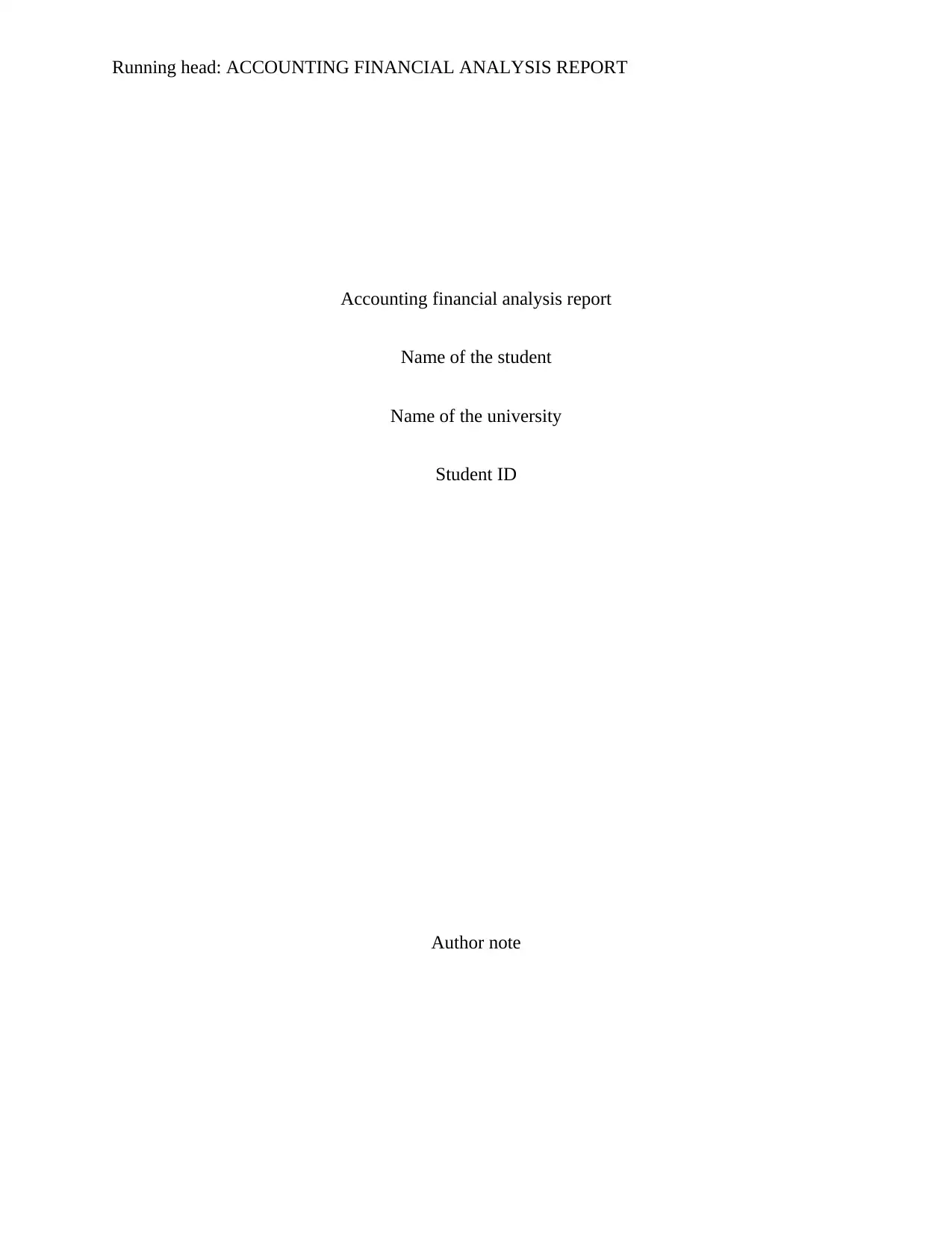
Running head: ACCOUNTING FINANCIAL ANALYSIS REPORT
Accounting financial analysis report
Name of the student
Name of the university
Student ID
Author note
Accounting financial analysis report
Name of the student
Name of the university
Student ID
Author note
Paraphrase This Document
Need a fresh take? Get an instant paraphrase of this document with our AI Paraphraser
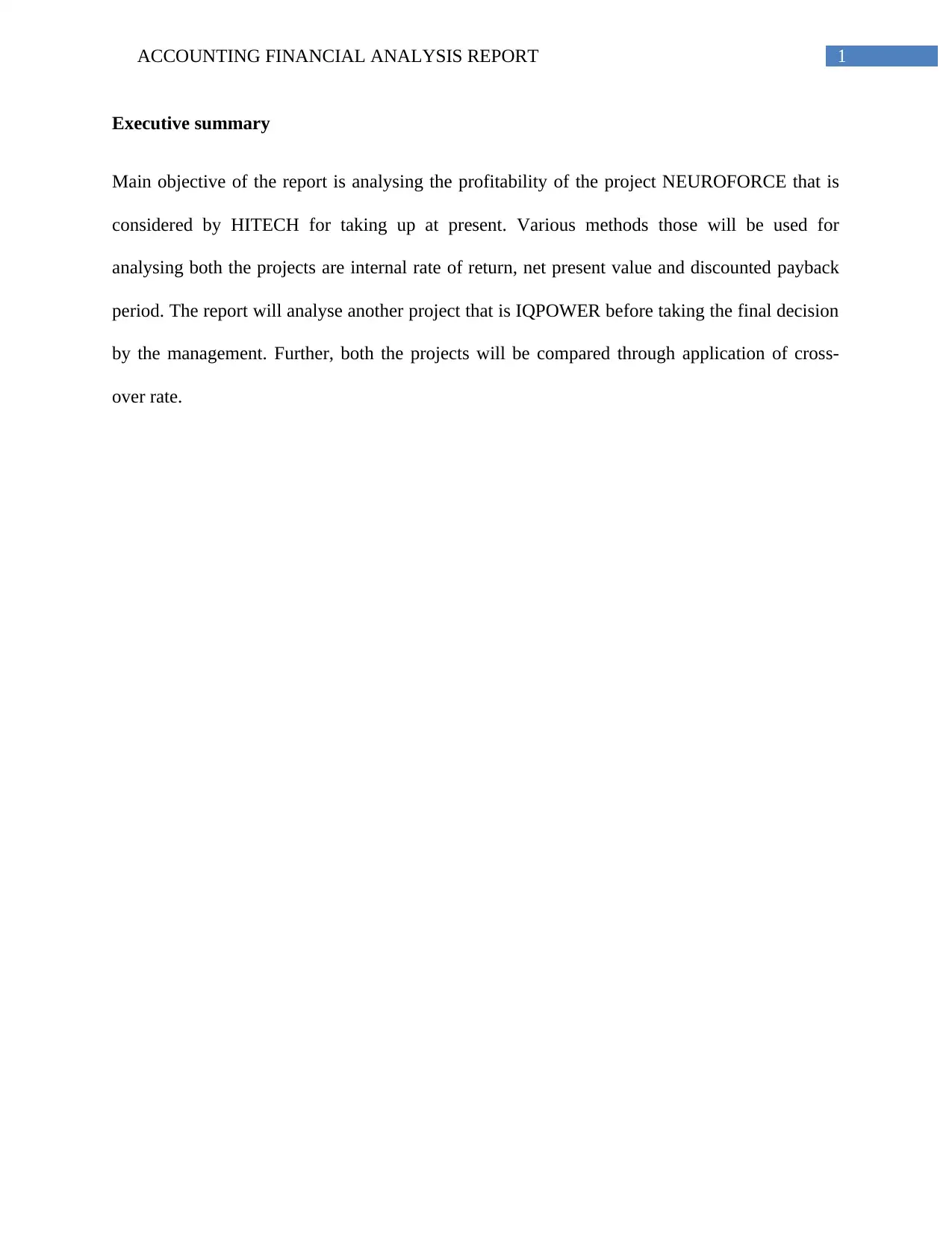
1ACCOUNTING FINANCIAL ANALYSIS REPORT
Executive summary
Main objective of the report is analysing the profitability of the project NEUROFORCE that is
considered by HITECH for taking up at present. Various methods those will be used for
analysing both the projects are internal rate of return, net present value and discounted payback
period. The report will analyse another project that is IQPOWER before taking the final decision
by the management. Further, both the projects will be compared through application of cross-
over rate.
Executive summary
Main objective of the report is analysing the profitability of the project NEUROFORCE that is
considered by HITECH for taking up at present. Various methods those will be used for
analysing both the projects are internal rate of return, net present value and discounted payback
period. The report will analyse another project that is IQPOWER before taking the final decision
by the management. Further, both the projects will be compared through application of cross-
over rate.
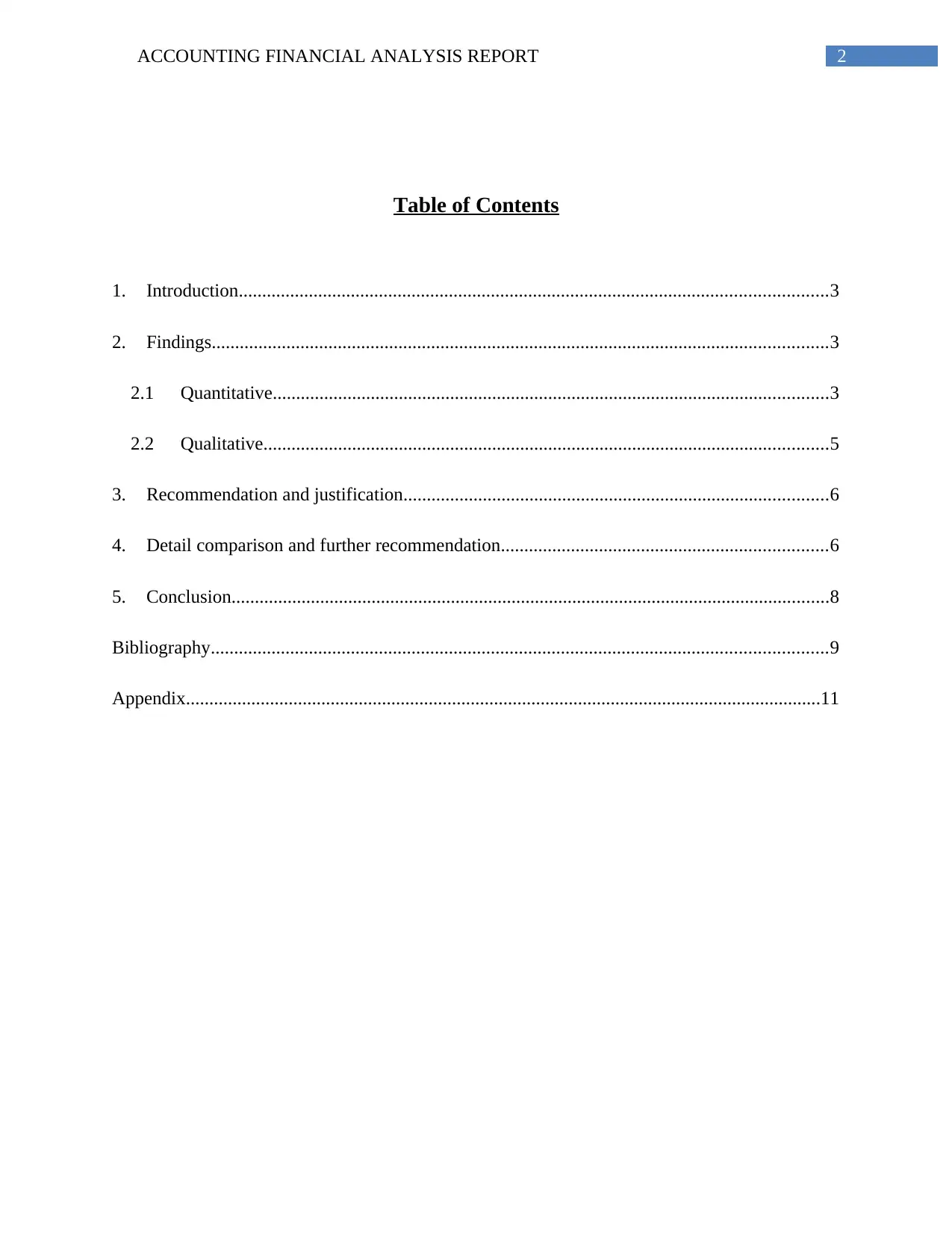
2ACCOUNTING FINANCIAL ANALYSIS REPORT
Table of Contents
1. Introduction..............................................................................................................................3
2. Findings....................................................................................................................................3
2.1 Quantitative.......................................................................................................................3
2.2 Qualitative.........................................................................................................................5
3. Recommendation and justification...........................................................................................6
4. Detail comparison and further recommendation......................................................................6
5. Conclusion................................................................................................................................8
Bibliography....................................................................................................................................9
Appendix........................................................................................................................................11
Table of Contents
1. Introduction..............................................................................................................................3
2. Findings....................................................................................................................................3
2.1 Quantitative.......................................................................................................................3
2.2 Qualitative.........................................................................................................................5
3. Recommendation and justification...........................................................................................6
4. Detail comparison and further recommendation......................................................................6
5. Conclusion................................................................................................................................8
Bibliography....................................................................................................................................9
Appendix........................................................................................................................................11
⊘ This is a preview!⊘
Do you want full access?
Subscribe today to unlock all pages.

Trusted by 1+ million students worldwide
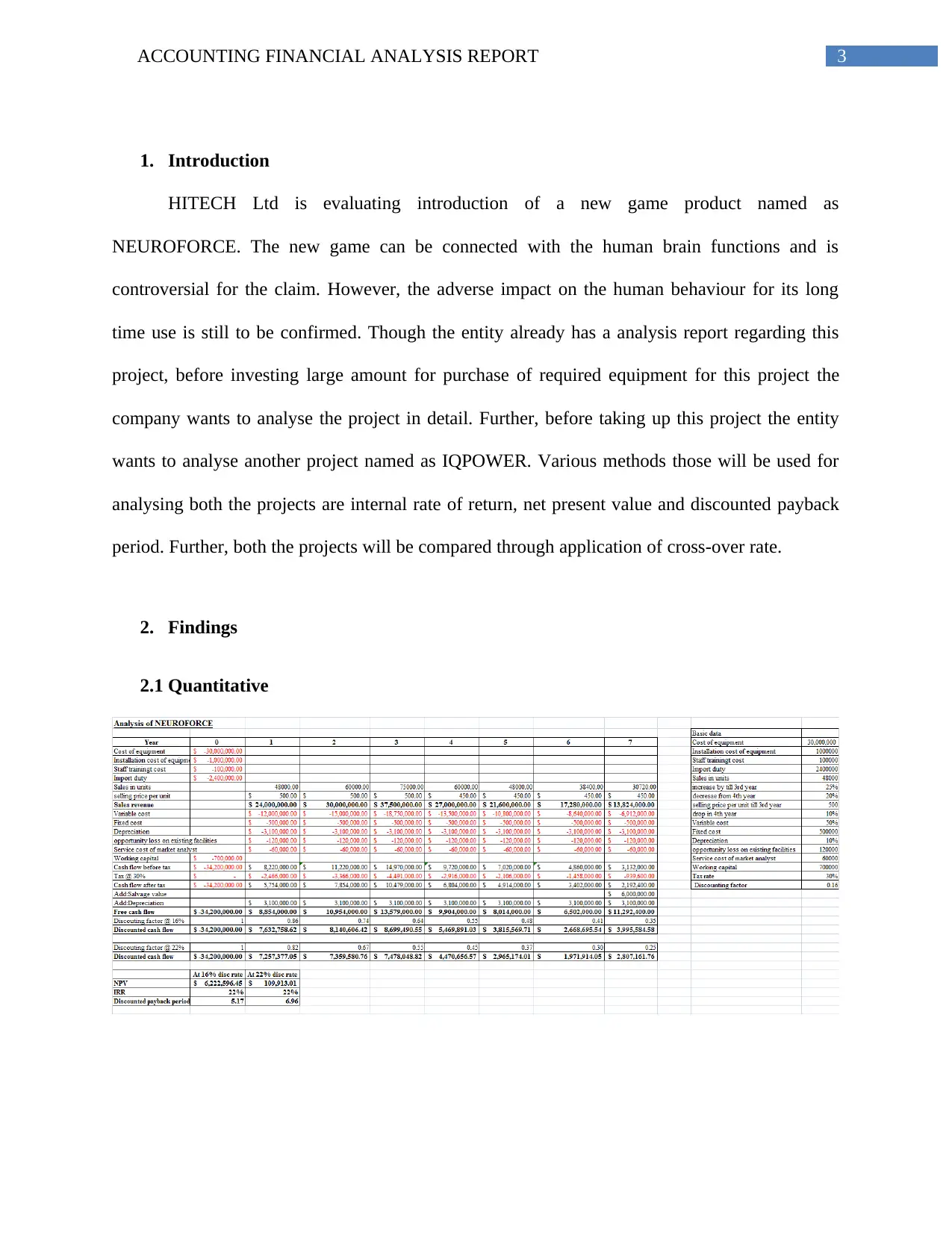
3ACCOUNTING FINANCIAL ANALYSIS REPORT
1. Introduction
HITECH Ltd is evaluating introduction of a new game product named as
NEUROFORCE. The new game can be connected with the human brain functions and is
controversial for the claim. However, the adverse impact on the human behaviour for its long
time use is still to be confirmed. Though the entity already has a analysis report regarding this
project, before investing large amount for purchase of required equipment for this project the
company wants to analyse the project in detail. Further, before taking up this project the entity
wants to analyse another project named as IQPOWER. Various methods those will be used for
analysing both the projects are internal rate of return, net present value and discounted payback
period. Further, both the projects will be compared through application of cross-over rate.
2. Findings
2.1 Quantitative
1. Introduction
HITECH Ltd is evaluating introduction of a new game product named as
NEUROFORCE. The new game can be connected with the human brain functions and is
controversial for the claim. However, the adverse impact on the human behaviour for its long
time use is still to be confirmed. Though the entity already has a analysis report regarding this
project, before investing large amount for purchase of required equipment for this project the
company wants to analyse the project in detail. Further, before taking up this project the entity
wants to analyse another project named as IQPOWER. Various methods those will be used for
analysing both the projects are internal rate of return, net present value and discounted payback
period. Further, both the projects will be compared through application of cross-over rate.
2. Findings
2.1 Quantitative
Paraphrase This Document
Need a fresh take? Get an instant paraphrase of this document with our AI Paraphraser
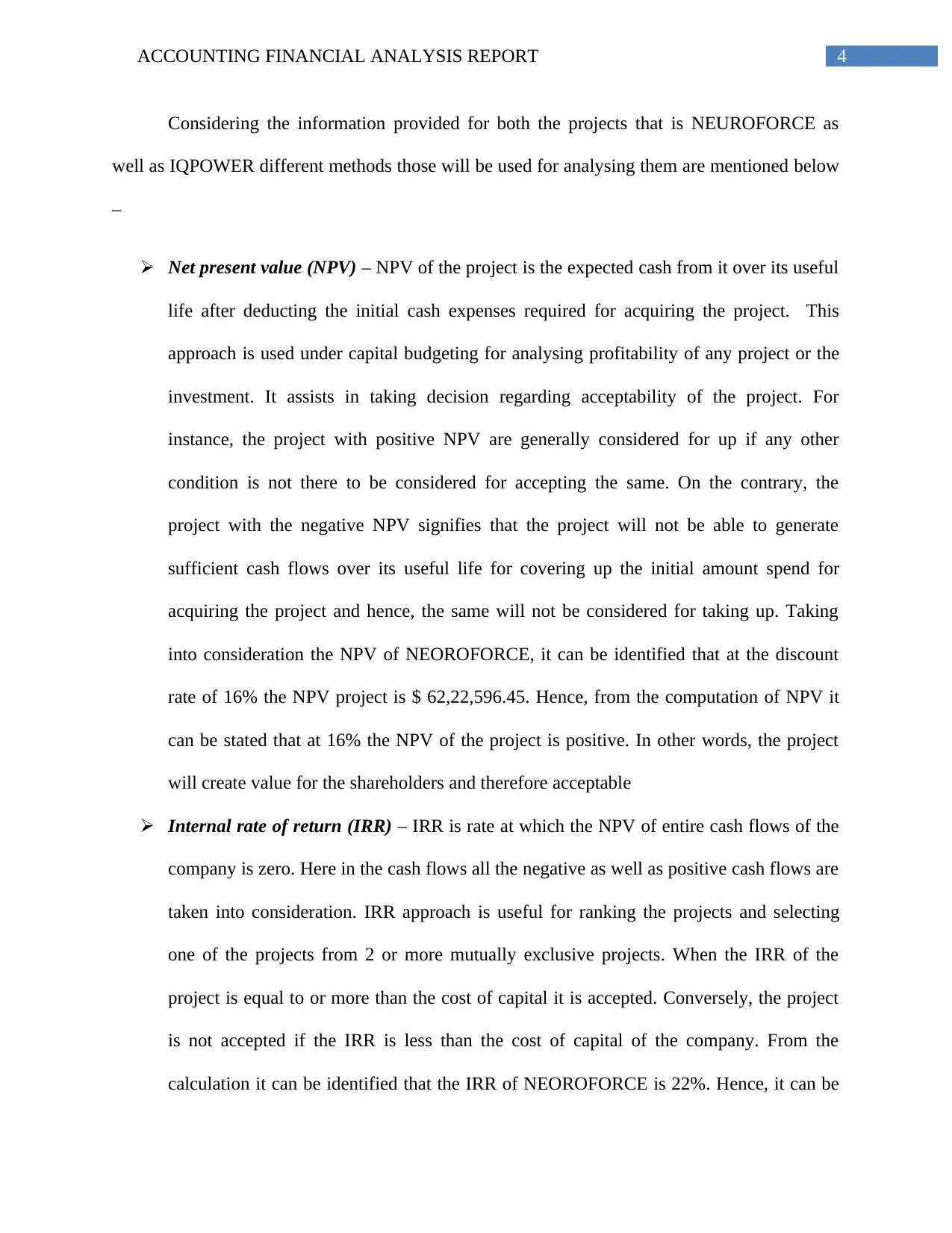
4ACCOUNTING FINANCIAL ANALYSIS REPORT
Considering the information provided for both the projects that is NEUROFORCE as
well as IQPOWER different methods those will be used for analysing them are mentioned below
–
Net present value (NPV) – NPV of the project is the expected cash from it over its useful
life after deducting the initial cash expenses required for acquiring the project. This
approach is used under capital budgeting for analysing profitability of any project or the
investment. It assists in taking decision regarding acceptability of the project. For
instance, the project with positive NPV are generally considered for up if any other
condition is not there to be considered for accepting the same. On the contrary, the
project with the negative NPV signifies that the project will not be able to generate
sufficient cash flows over its useful life for covering up the initial amount spend for
acquiring the project and hence, the same will not be considered for taking up. Taking
into consideration the NPV of NEOROFORCE, it can be identified that at the discount
rate of 16% the NPV project is $ 62,22,596.45. Hence, from the computation of NPV it
can be stated that at 16% the NPV of the project is positive. In other words, the project
will create value for the shareholders and therefore acceptable
Internal rate of return (IRR) – IRR is rate at which the NPV of entire cash flows of the
company is zero. Here in the cash flows all the negative as well as positive cash flows are
taken into consideration. IRR approach is useful for ranking the projects and selecting
one of the projects from 2 or more mutually exclusive projects. When the IRR of the
project is equal to or more than the cost of capital it is accepted. Conversely, the project
is not accepted if the IRR is less than the cost of capital of the company. From the
calculation it can be identified that the IRR of NEOROFORCE is 22%. Hence, it can be
Considering the information provided for both the projects that is NEUROFORCE as
well as IQPOWER different methods those will be used for analysing them are mentioned below
–
Net present value (NPV) – NPV of the project is the expected cash from it over its useful
life after deducting the initial cash expenses required for acquiring the project. This
approach is used under capital budgeting for analysing profitability of any project or the
investment. It assists in taking decision regarding acceptability of the project. For
instance, the project with positive NPV are generally considered for up if any other
condition is not there to be considered for accepting the same. On the contrary, the
project with the negative NPV signifies that the project will not be able to generate
sufficient cash flows over its useful life for covering up the initial amount spend for
acquiring the project and hence, the same will not be considered for taking up. Taking
into consideration the NPV of NEOROFORCE, it can be identified that at the discount
rate of 16% the NPV project is $ 62,22,596.45. Hence, from the computation of NPV it
can be stated that at 16% the NPV of the project is positive. In other words, the project
will create value for the shareholders and therefore acceptable
Internal rate of return (IRR) – IRR is rate at which the NPV of entire cash flows of the
company is zero. Here in the cash flows all the negative as well as positive cash flows are
taken into consideration. IRR approach is useful for ranking the projects and selecting
one of the projects from 2 or more mutually exclusive projects. When the IRR of the
project is equal to or more than the cost of capital it is accepted. Conversely, the project
is not accepted if the IRR is less than the cost of capital of the company. From the
calculation it can be identified that the IRR of NEOROFORCE is 22%. Hence, it can be
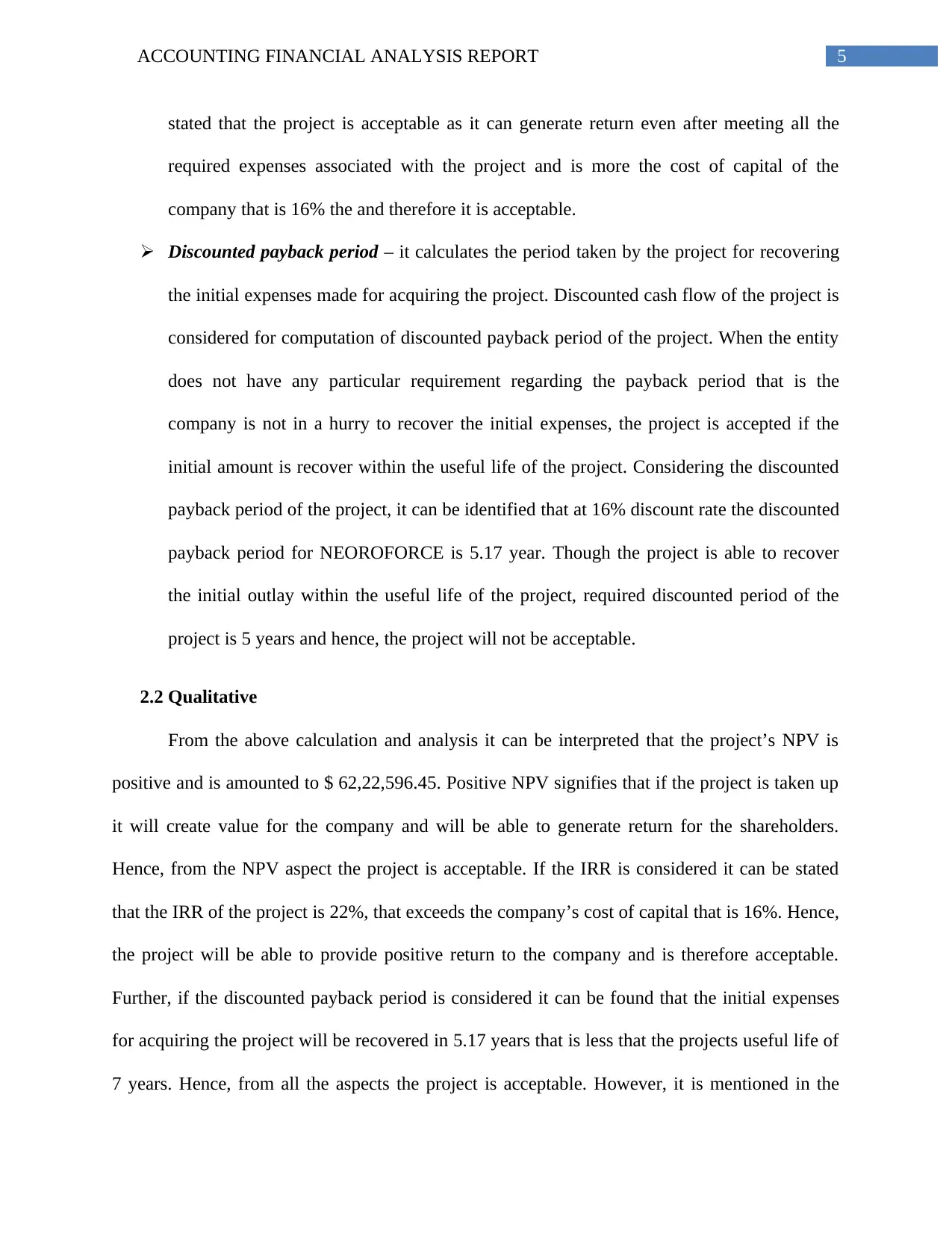
5ACCOUNTING FINANCIAL ANALYSIS REPORT
stated that the project is acceptable as it can generate return even after meeting all the
required expenses associated with the project and is more the cost of capital of the
company that is 16% the and therefore it is acceptable.
Discounted payback period – it calculates the period taken by the project for recovering
the initial expenses made for acquiring the project. Discounted cash flow of the project is
considered for computation of discounted payback period of the project. When the entity
does not have any particular requirement regarding the payback period that is the
company is not in a hurry to recover the initial expenses, the project is accepted if the
initial amount is recover within the useful life of the project. Considering the discounted
payback period of the project, it can be identified that at 16% discount rate the discounted
payback period for NEOROFORCE is 5.17 year. Though the project is able to recover
the initial outlay within the useful life of the project, required discounted period of the
project is 5 years and hence, the project will not be acceptable.
2.2 Qualitative
From the above calculation and analysis it can be interpreted that the project’s NPV is
positive and is amounted to $ 62,22,596.45. Positive NPV signifies that if the project is taken up
it will create value for the company and will be able to generate return for the shareholders.
Hence, from the NPV aspect the project is acceptable. If the IRR is considered it can be stated
that the IRR of the project is 22%, that exceeds the company’s cost of capital that is 16%. Hence,
the project will be able to provide positive return to the company and is therefore acceptable.
Further, if the discounted payback period is considered it can be found that the initial expenses
for acquiring the project will be recovered in 5.17 years that is less that the projects useful life of
7 years. Hence, from all the aspects the project is acceptable. However, it is mentioned in the
stated that the project is acceptable as it can generate return even after meeting all the
required expenses associated with the project and is more the cost of capital of the
company that is 16% the and therefore it is acceptable.
Discounted payback period – it calculates the period taken by the project for recovering
the initial expenses made for acquiring the project. Discounted cash flow of the project is
considered for computation of discounted payback period of the project. When the entity
does not have any particular requirement regarding the payback period that is the
company is not in a hurry to recover the initial expenses, the project is accepted if the
initial amount is recover within the useful life of the project. Considering the discounted
payback period of the project, it can be identified that at 16% discount rate the discounted
payback period for NEOROFORCE is 5.17 year. Though the project is able to recover
the initial outlay within the useful life of the project, required discounted period of the
project is 5 years and hence, the project will not be acceptable.
2.2 Qualitative
From the above calculation and analysis it can be interpreted that the project’s NPV is
positive and is amounted to $ 62,22,596.45. Positive NPV signifies that if the project is taken up
it will create value for the company and will be able to generate return for the shareholders.
Hence, from the NPV aspect the project is acceptable. If the IRR is considered it can be stated
that the IRR of the project is 22%, that exceeds the company’s cost of capital that is 16%. Hence,
the project will be able to provide positive return to the company and is therefore acceptable.
Further, if the discounted payback period is considered it can be found that the initial expenses
for acquiring the project will be recovered in 5.17 years that is less that the projects useful life of
7 years. Hence, from all the aspects the project is acceptable. However, it is mentioned in the
⊘ This is a preview!⊘
Do you want full access?
Subscribe today to unlock all pages.

Trusted by 1+ million students worldwide
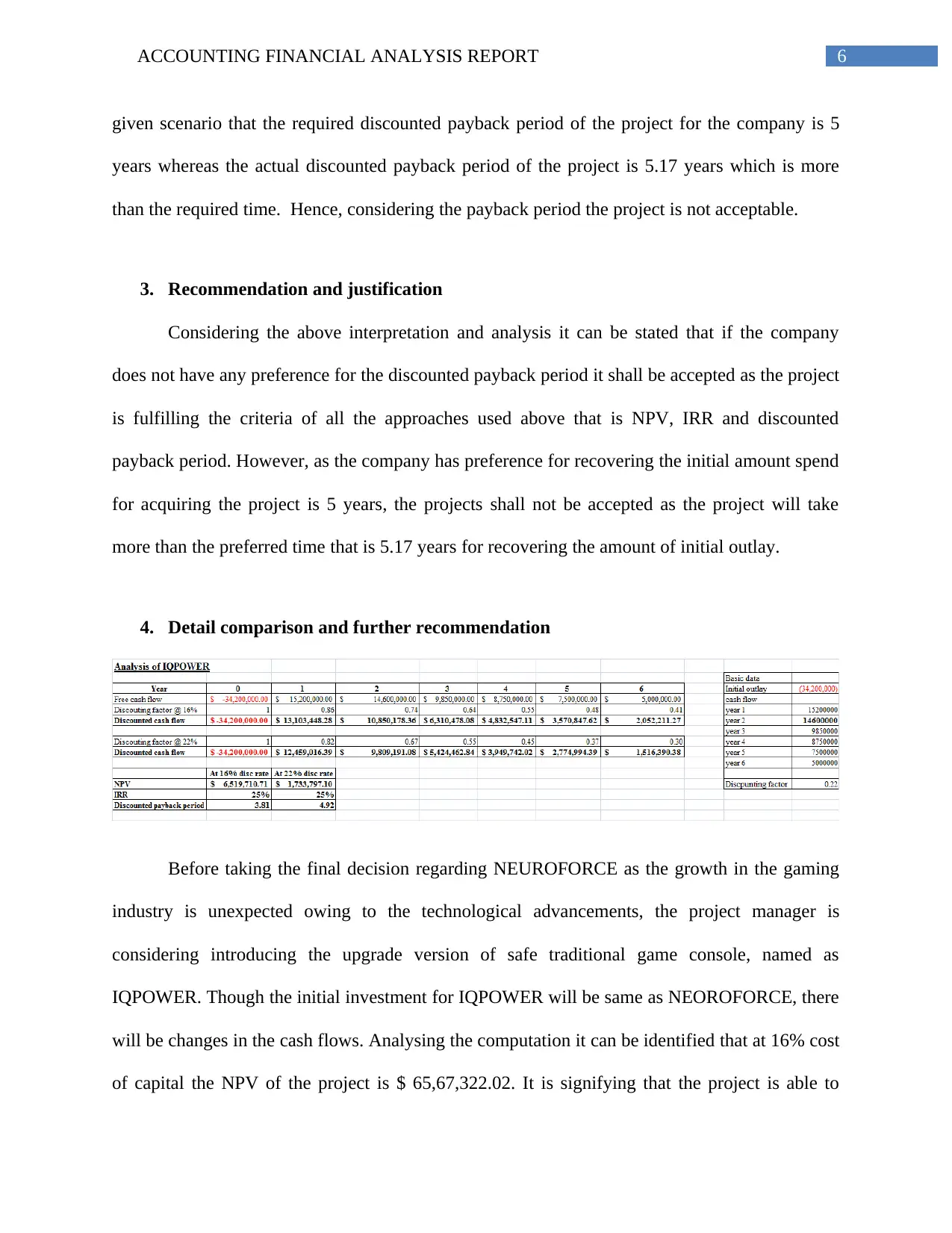
6ACCOUNTING FINANCIAL ANALYSIS REPORT
given scenario that the required discounted payback period of the project for the company is 5
years whereas the actual discounted payback period of the project is 5.17 years which is more
than the required time. Hence, considering the payback period the project is not acceptable.
3. Recommendation and justification
Considering the above interpretation and analysis it can be stated that if the company
does not have any preference for the discounted payback period it shall be accepted as the project
is fulfilling the criteria of all the approaches used above that is NPV, IRR and discounted
payback period. However, as the company has preference for recovering the initial amount spend
for acquiring the project is 5 years, the projects shall not be accepted as the project will take
more than the preferred time that is 5.17 years for recovering the amount of initial outlay.
4. Detail comparison and further recommendation
Before taking the final decision regarding NEUROFORCE as the growth in the gaming
industry is unexpected owing to the technological advancements, the project manager is
considering introducing the upgrade version of safe traditional game console, named as
IQPOWER. Though the initial investment for IQPOWER will be same as NEOROFORCE, there
will be changes in the cash flows. Analysing the computation it can be identified that at 16% cost
of capital the NPV of the project is $ 65,67,322.02. It is signifying that the project is able to
given scenario that the required discounted payback period of the project for the company is 5
years whereas the actual discounted payback period of the project is 5.17 years which is more
than the required time. Hence, considering the payback period the project is not acceptable.
3. Recommendation and justification
Considering the above interpretation and analysis it can be stated that if the company
does not have any preference for the discounted payback period it shall be accepted as the project
is fulfilling the criteria of all the approaches used above that is NPV, IRR and discounted
payback period. However, as the company has preference for recovering the initial amount spend
for acquiring the project is 5 years, the projects shall not be accepted as the project will take
more than the preferred time that is 5.17 years for recovering the amount of initial outlay.
4. Detail comparison and further recommendation
Before taking the final decision regarding NEUROFORCE as the growth in the gaming
industry is unexpected owing to the technological advancements, the project manager is
considering introducing the upgrade version of safe traditional game console, named as
IQPOWER. Though the initial investment for IQPOWER will be same as NEOROFORCE, there
will be changes in the cash flows. Analysing the computation it can be identified that at 16% cost
of capital the NPV of the project is $ 65,67,322.02. It is signifying that the project is able to
Paraphrase This Document
Need a fresh take? Get an instant paraphrase of this document with our AI Paraphraser
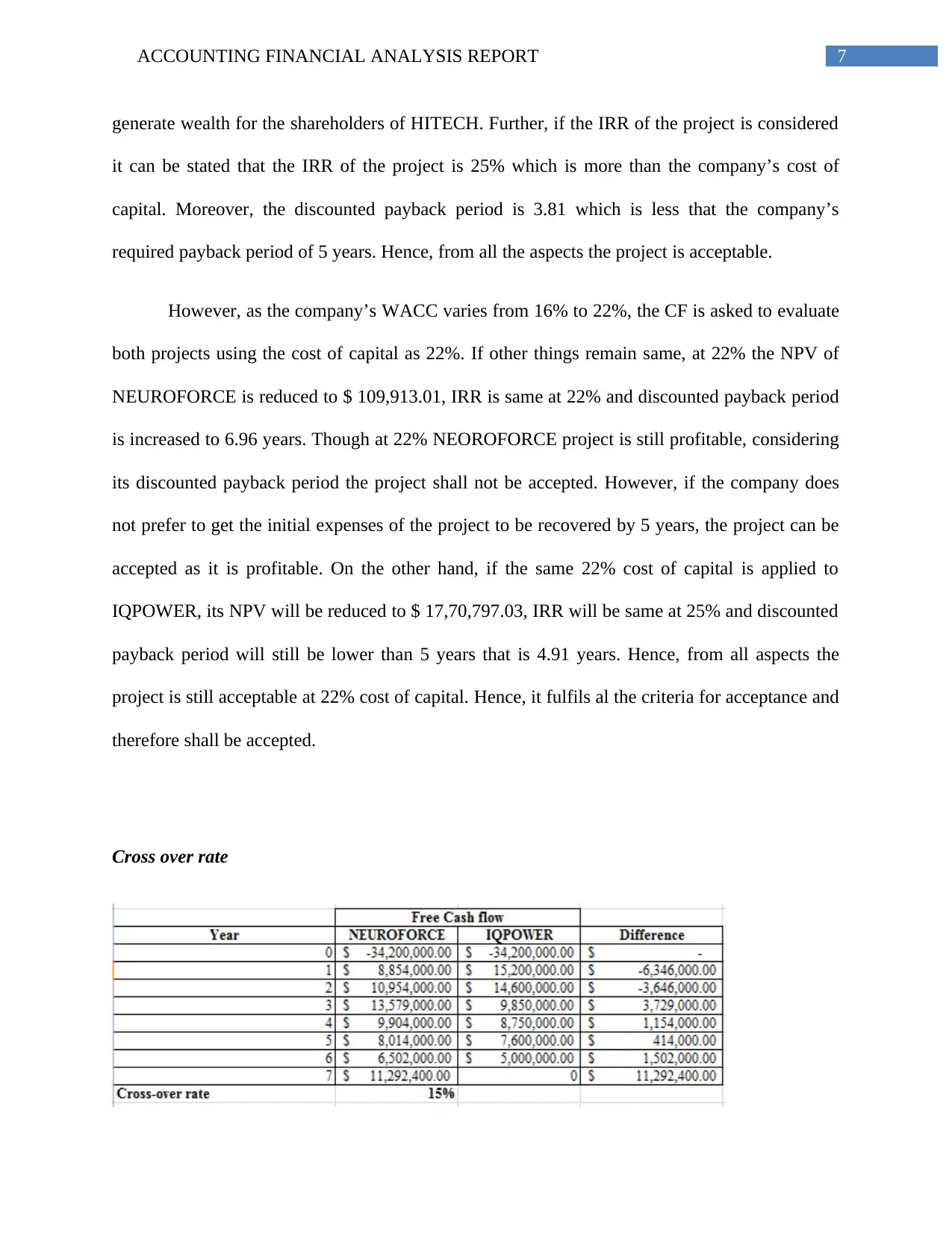
7ACCOUNTING FINANCIAL ANALYSIS REPORT
generate wealth for the shareholders of HITECH. Further, if the IRR of the project is considered
it can be stated that the IRR of the project is 25% which is more than the company’s cost of
capital. Moreover, the discounted payback period is 3.81 which is less that the company’s
required payback period of 5 years. Hence, from all the aspects the project is acceptable.
However, as the company’s WACC varies from 16% to 22%, the CF is asked to evaluate
both projects using the cost of capital as 22%. If other things remain same, at 22% the NPV of
NEUROFORCE is reduced to $ 109,913.01, IRR is same at 22% and discounted payback period
is increased to 6.96 years. Though at 22% NEOROFORCE project is still profitable, considering
its discounted payback period the project shall not be accepted. However, if the company does
not prefer to get the initial expenses of the project to be recovered by 5 years, the project can be
accepted as it is profitable. On the other hand, if the same 22% cost of capital is applied to
IQPOWER, its NPV will be reduced to $ 17,70,797.03, IRR will be same at 25% and discounted
payback period will still be lower than 5 years that is 4.91 years. Hence, from all aspects the
project is still acceptable at 22% cost of capital. Hence, it fulfils al the criteria for acceptance and
therefore shall be accepted.
Cross over rate
generate wealth for the shareholders of HITECH. Further, if the IRR of the project is considered
it can be stated that the IRR of the project is 25% which is more than the company’s cost of
capital. Moreover, the discounted payback period is 3.81 which is less that the company’s
required payback period of 5 years. Hence, from all the aspects the project is acceptable.
However, as the company’s WACC varies from 16% to 22%, the CF is asked to evaluate
both projects using the cost of capital as 22%. If other things remain same, at 22% the NPV of
NEUROFORCE is reduced to $ 109,913.01, IRR is same at 22% and discounted payback period
is increased to 6.96 years. Though at 22% NEOROFORCE project is still profitable, considering
its discounted payback period the project shall not be accepted. However, if the company does
not prefer to get the initial expenses of the project to be recovered by 5 years, the project can be
accepted as it is profitable. On the other hand, if the same 22% cost of capital is applied to
IQPOWER, its NPV will be reduced to $ 17,70,797.03, IRR will be same at 25% and discounted
payback period will still be lower than 5 years that is 4.91 years. Hence, from all aspects the
project is still acceptable at 22% cost of capital. Hence, it fulfils al the criteria for acceptance and
therefore shall be accepted.
Cross over rate
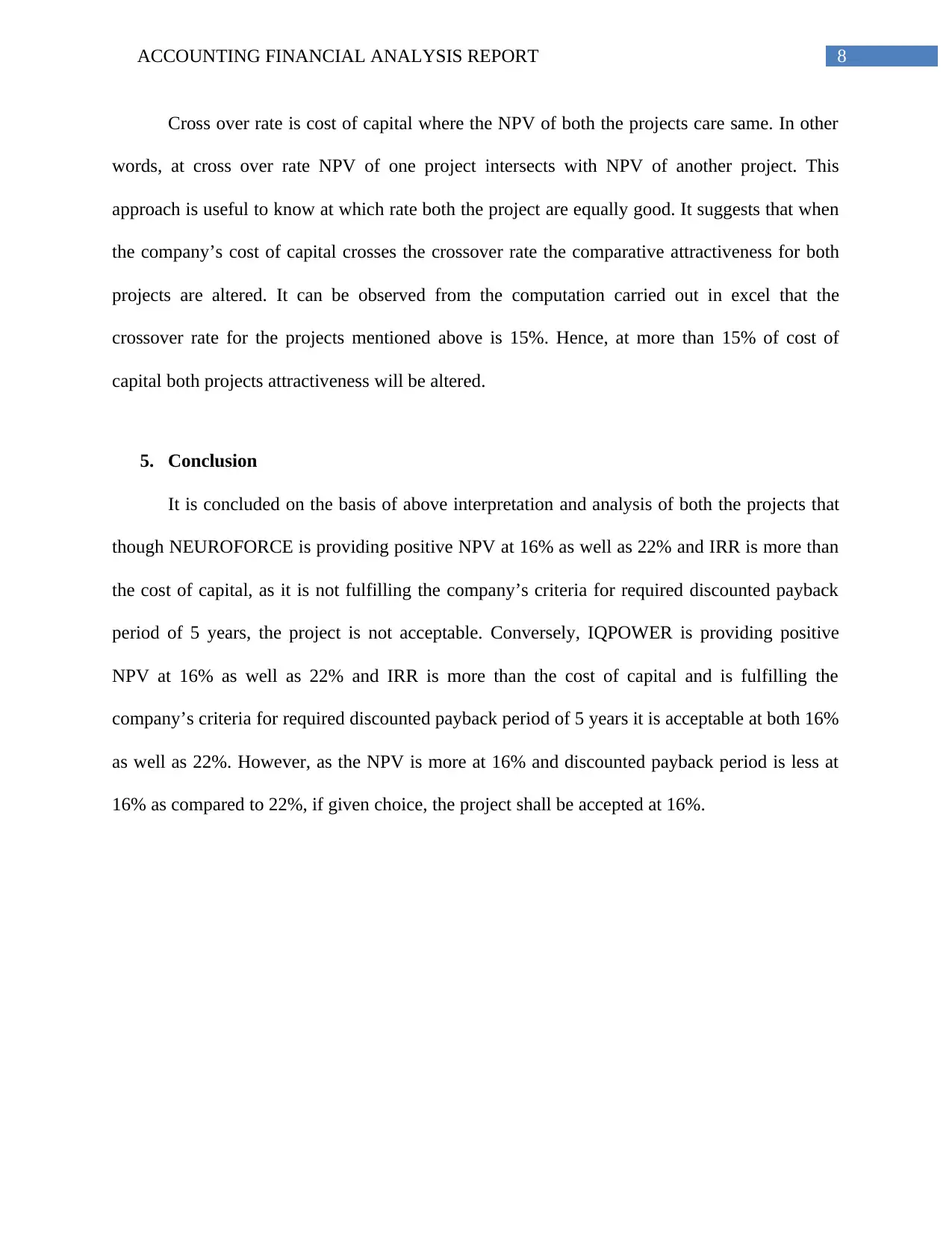
8ACCOUNTING FINANCIAL ANALYSIS REPORT
Cross over rate is cost of capital where the NPV of both the projects care same. In other
words, at cross over rate NPV of one project intersects with NPV of another project. This
approach is useful to know at which rate both the project are equally good. It suggests that when
the company’s cost of capital crosses the crossover rate the comparative attractiveness for both
projects are altered. It can be observed from the computation carried out in excel that the
crossover rate for the projects mentioned above is 15%. Hence, at more than 15% of cost of
capital both projects attractiveness will be altered.
5. Conclusion
It is concluded on the basis of above interpretation and analysis of both the projects that
though NEUROFORCE is providing positive NPV at 16% as well as 22% and IRR is more than
the cost of capital, as it is not fulfilling the company’s criteria for required discounted payback
period of 5 years, the project is not acceptable. Conversely, IQPOWER is providing positive
NPV at 16% as well as 22% and IRR is more than the cost of capital and is fulfilling the
company’s criteria for required discounted payback period of 5 years it is acceptable at both 16%
as well as 22%. However, as the NPV is more at 16% and discounted payback period is less at
16% as compared to 22%, if given choice, the project shall be accepted at 16%.
Cross over rate is cost of capital where the NPV of both the projects care same. In other
words, at cross over rate NPV of one project intersects with NPV of another project. This
approach is useful to know at which rate both the project are equally good. It suggests that when
the company’s cost of capital crosses the crossover rate the comparative attractiveness for both
projects are altered. It can be observed from the computation carried out in excel that the
crossover rate for the projects mentioned above is 15%. Hence, at more than 15% of cost of
capital both projects attractiveness will be altered.
5. Conclusion
It is concluded on the basis of above interpretation and analysis of both the projects that
though NEUROFORCE is providing positive NPV at 16% as well as 22% and IRR is more than
the cost of capital, as it is not fulfilling the company’s criteria for required discounted payback
period of 5 years, the project is not acceptable. Conversely, IQPOWER is providing positive
NPV at 16% as well as 22% and IRR is more than the cost of capital and is fulfilling the
company’s criteria for required discounted payback period of 5 years it is acceptable at both 16%
as well as 22%. However, as the NPV is more at 16% and discounted payback period is less at
16% as compared to 22%, if given choice, the project shall be accepted at 16%.
⊘ This is a preview!⊘
Do you want full access?
Subscribe today to unlock all pages.

Trusted by 1+ million students worldwide
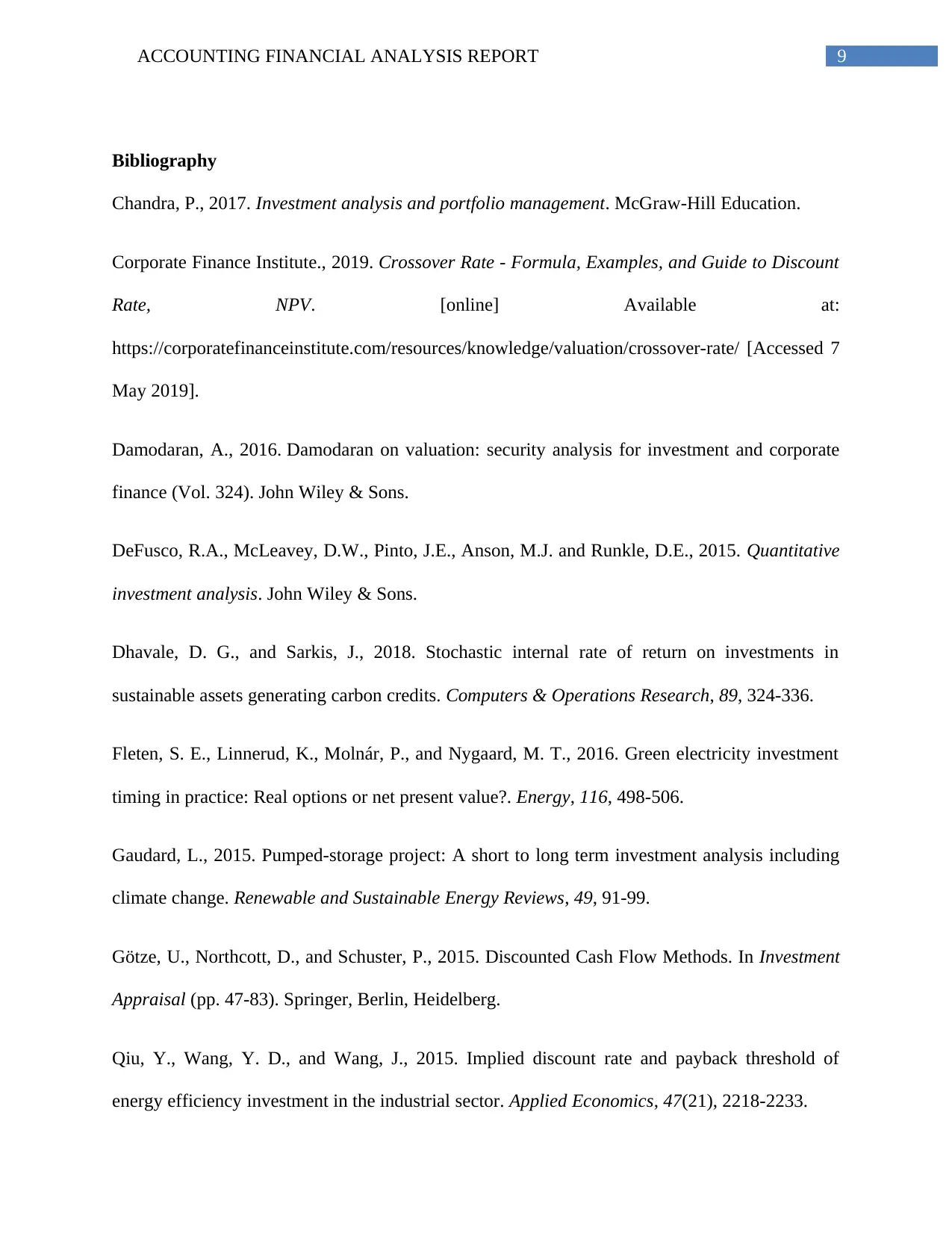
9ACCOUNTING FINANCIAL ANALYSIS REPORT
Bibliography
Chandra, P., 2017. Investment analysis and portfolio management. McGraw-Hill Education.
Corporate Finance Institute., 2019. Crossover Rate - Formula, Examples, and Guide to Discount
Rate, NPV. [online] Available at:
https://corporatefinanceinstitute.com/resources/knowledge/valuation/crossover-rate/ [Accessed 7
May 2019].
Damodaran, A., 2016. Damodaran on valuation: security analysis for investment and corporate
finance (Vol. 324). John Wiley & Sons.
DeFusco, R.A., McLeavey, D.W., Pinto, J.E., Anson, M.J. and Runkle, D.E., 2015. Quantitative
investment analysis. John Wiley & Sons.
Dhavale, D. G., and Sarkis, J., 2018. Stochastic internal rate of return on investments in
sustainable assets generating carbon credits. Computers & Operations Research, 89, 324-336.
Fleten, S. E., Linnerud, K., Molnár, P., and Nygaard, M. T., 2016. Green electricity investment
timing in practice: Real options or net present value?. Energy, 116, 498-506.
Gaudard, L., 2015. Pumped-storage project: A short to long term investment analysis including
climate change. Renewable and Sustainable Energy Reviews, 49, 91-99.
Götze, U., Northcott, D., and Schuster, P., 2015. Discounted Cash Flow Methods. In Investment
Appraisal (pp. 47-83). Springer, Berlin, Heidelberg.
Qiu, Y., Wang, Y. D., and Wang, J., 2015. Implied discount rate and payback threshold of
energy efficiency investment in the industrial sector. Applied Economics, 47(21), 2218-2233.
Bibliography
Chandra, P., 2017. Investment analysis and portfolio management. McGraw-Hill Education.
Corporate Finance Institute., 2019. Crossover Rate - Formula, Examples, and Guide to Discount
Rate, NPV. [online] Available at:
https://corporatefinanceinstitute.com/resources/knowledge/valuation/crossover-rate/ [Accessed 7
May 2019].
Damodaran, A., 2016. Damodaran on valuation: security analysis for investment and corporate
finance (Vol. 324). John Wiley & Sons.
DeFusco, R.A., McLeavey, D.W., Pinto, J.E., Anson, M.J. and Runkle, D.E., 2015. Quantitative
investment analysis. John Wiley & Sons.
Dhavale, D. G., and Sarkis, J., 2018. Stochastic internal rate of return on investments in
sustainable assets generating carbon credits. Computers & Operations Research, 89, 324-336.
Fleten, S. E., Linnerud, K., Molnár, P., and Nygaard, M. T., 2016. Green electricity investment
timing in practice: Real options or net present value?. Energy, 116, 498-506.
Gaudard, L., 2015. Pumped-storage project: A short to long term investment analysis including
climate change. Renewable and Sustainable Energy Reviews, 49, 91-99.
Götze, U., Northcott, D., and Schuster, P., 2015. Discounted Cash Flow Methods. In Investment
Appraisal (pp. 47-83). Springer, Berlin, Heidelberg.
Qiu, Y., Wang, Y. D., and Wang, J., 2015. Implied discount rate and payback threshold of
energy efficiency investment in the industrial sector. Applied Economics, 47(21), 2218-2233.
Paraphrase This Document
Need a fresh take? Get an instant paraphrase of this document with our AI Paraphraser
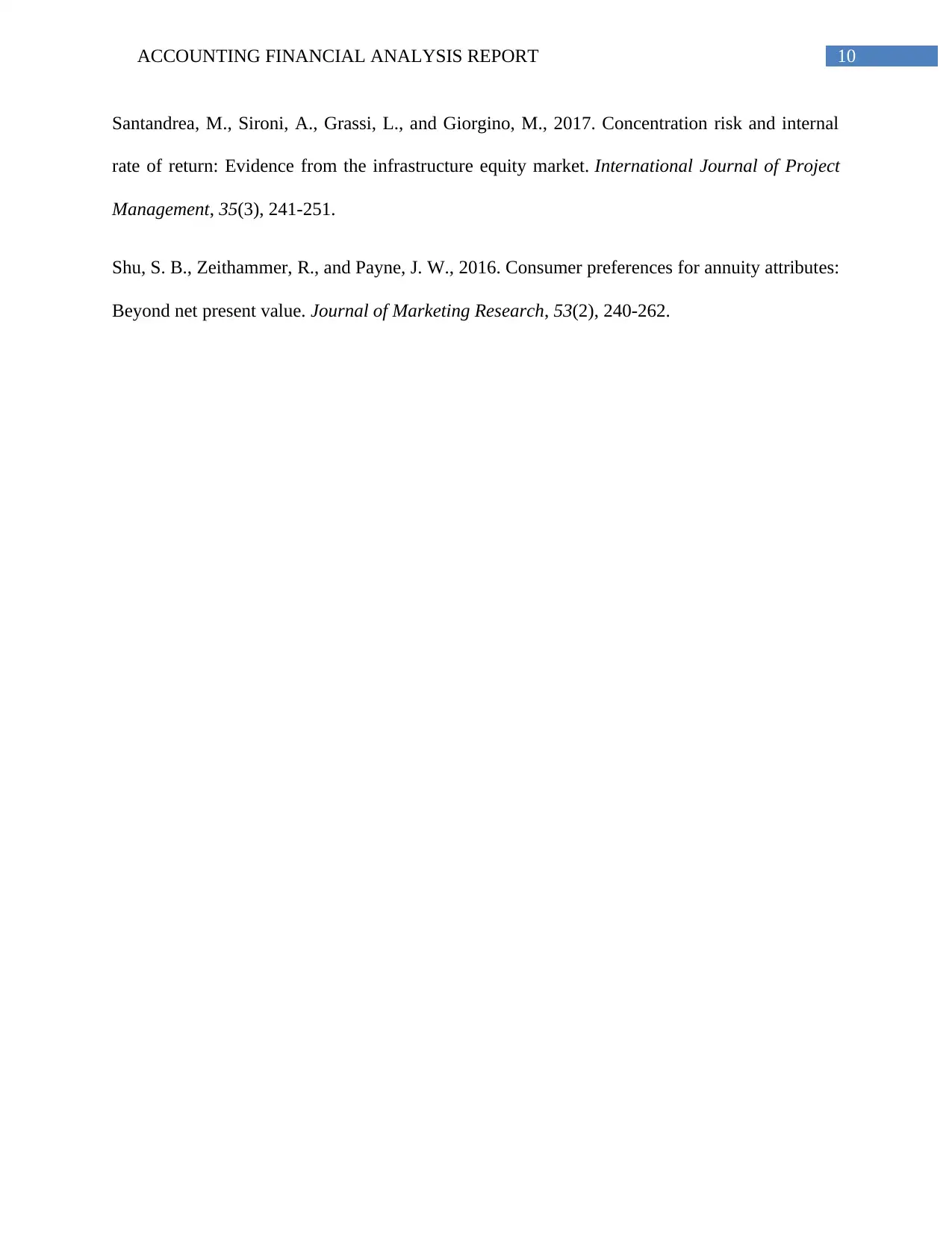
10ACCOUNTING FINANCIAL ANALYSIS REPORT
Santandrea, M., Sironi, A., Grassi, L., and Giorgino, M., 2017. Concentration risk and internal
rate of return: Evidence from the infrastructure equity market. International Journal of Project
Management, 35(3), 241-251.
Shu, S. B., Zeithammer, R., and Payne, J. W., 2016. Consumer preferences for annuity attributes:
Beyond net present value. Journal of Marketing Research, 53(2), 240-262.
Santandrea, M., Sironi, A., Grassi, L., and Giorgino, M., 2017. Concentration risk and internal
rate of return: Evidence from the infrastructure equity market. International Journal of Project
Management, 35(3), 241-251.
Shu, S. B., Zeithammer, R., and Payne, J. W., 2016. Consumer preferences for annuity attributes:
Beyond net present value. Journal of Marketing Research, 53(2), 240-262.
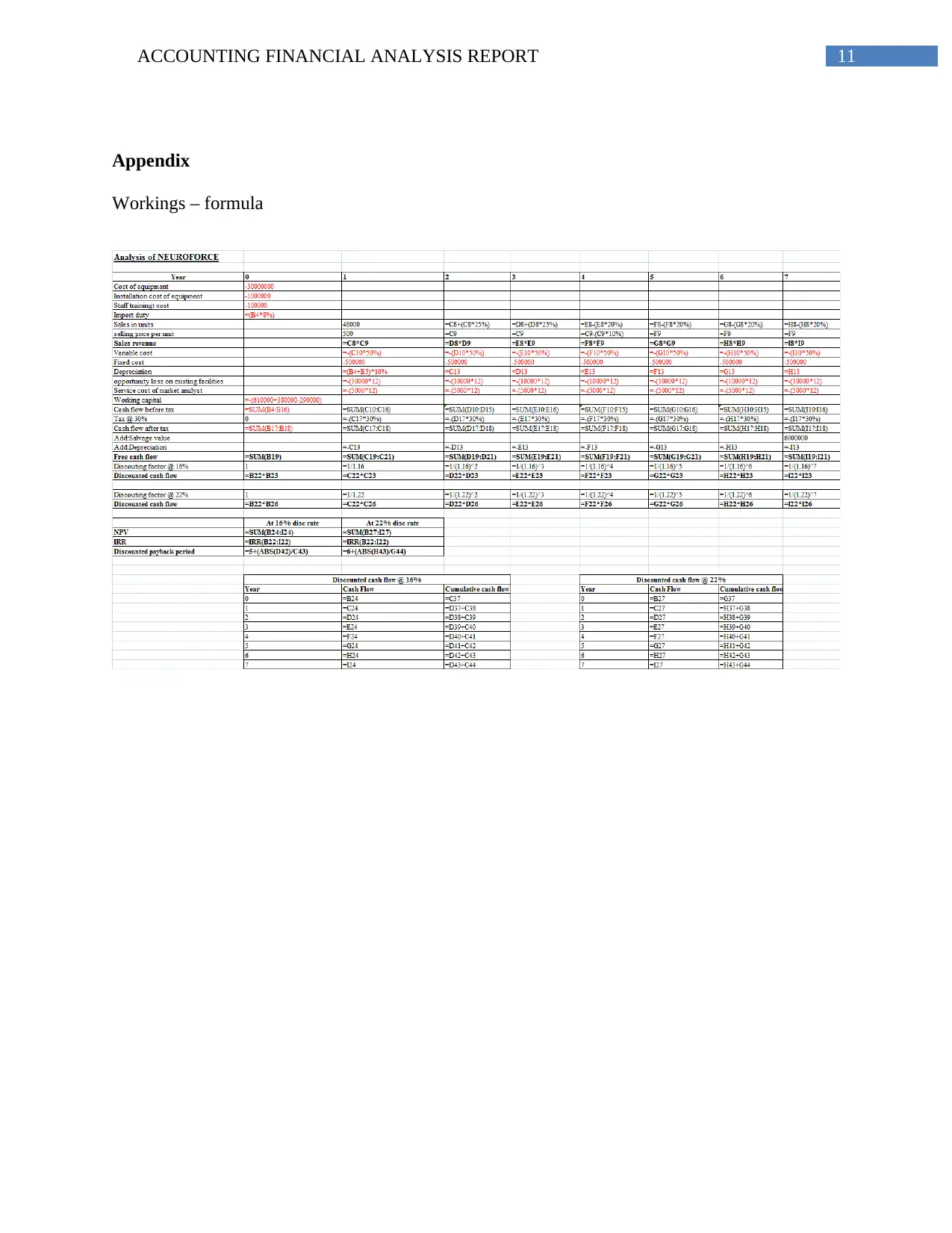
11ACCOUNTING FINANCIAL ANALYSIS REPORT
Appendix
Workings – formula
Appendix
Workings – formula
⊘ This is a preview!⊘
Do you want full access?
Subscribe today to unlock all pages.

Trusted by 1+ million students worldwide
1 out of 13
Related Documents
Your All-in-One AI-Powered Toolkit for Academic Success.
+13062052269
info@desklib.com
Available 24*7 on WhatsApp / Email
![[object Object]](/_next/static/media/star-bottom.7253800d.svg)
Unlock your academic potential
Copyright © 2020–2025 A2Z Services. All Rights Reserved. Developed and managed by ZUCOL.





